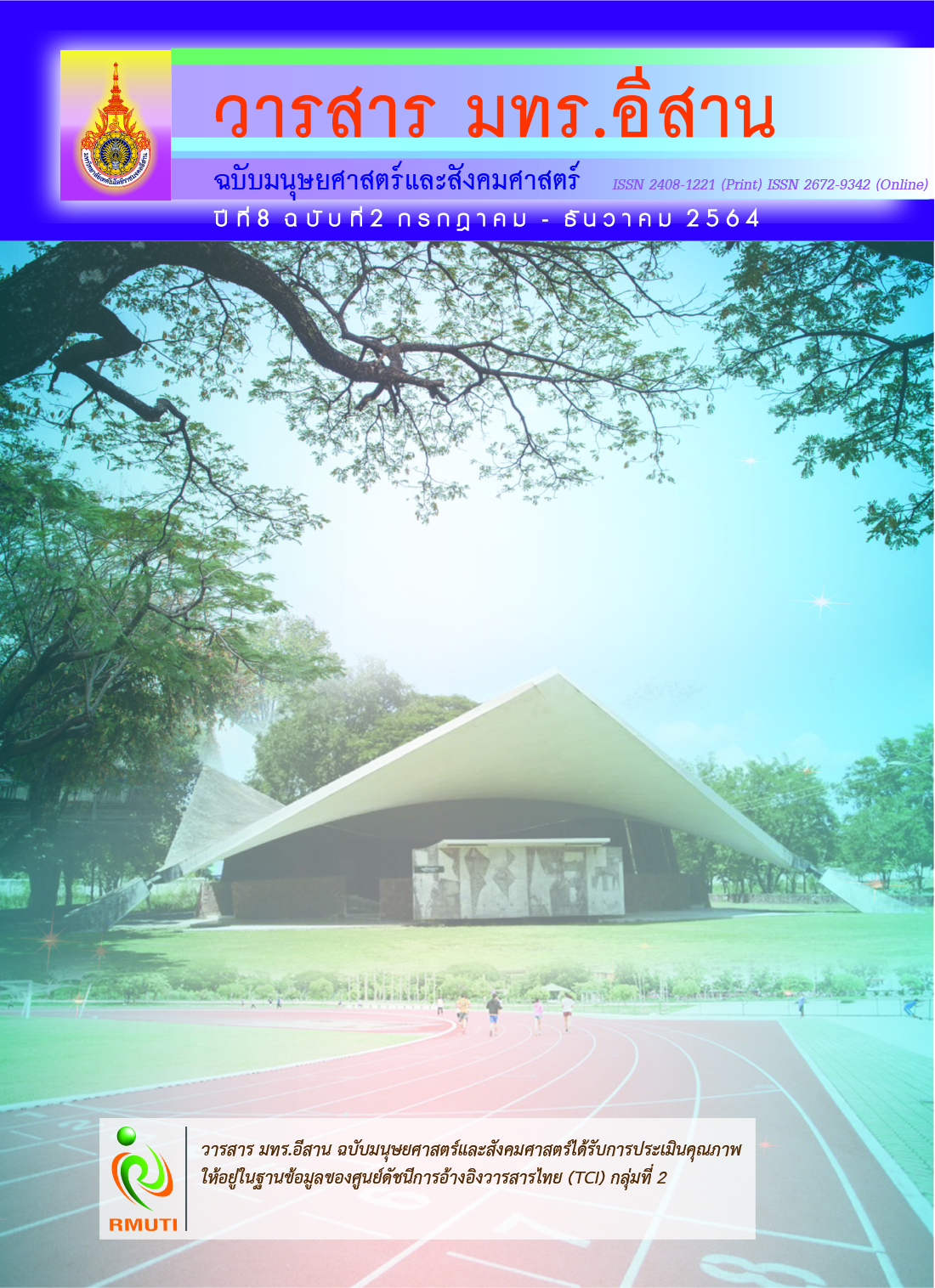การศึกษาการเปลี่ยนแปลงทุนทางสังคมเพื่อส่งเสริมความเข้มแข็งของชุมชน อย่างยั่งยืน: กรณีศึกษาชุมชนแพรกบางหมู ตำบลหนามแดง อำเภอเมือง จังหวัดฉะเชิงเทรา
Main Article Content
บทคัดย่อ
การวิจัยนี้มีวัตถุประสงค์เพื่อศึกษา 1) สภาพของทุนทางสังคมของชุมชน 2) ปัจจัยที่ส่งผลต่อการเปลี่ยนแปลงทุนทางสังคมเพื่อส่งเสริมความเข้มแข็งของชุมชนอย่างยั่งยืนและ 3) แนวทางการจัดการเพื่อส่งเสริม ชุมชนเข้มแข็งอย่างยั่งยืนของชุมชนแพรกบางหมู จังหวัดฉะเชิงเทรา เป็นการวิจัยแบบผสมผสานวิธีการ วิจัยเชิงปริมาณและเชิงคุณภาพ เก็บข้อมูลจากกลุ่มตัวอย่างจำนวน 192 คน ที่เป็นสมาชิกภายในชุมชน แพรกบางหมู ตำบลหนามแดง อำเภอเมือง จังหวัดฉะเชิงเทรา ที่กำหนดขนาดตัวอย่างตามแนวปฏิบัติ ของเครจซี่ และมอร์แกน (Krejcie, R. V. and Morgan, D. W., 1970) และกลุ่มที่สัมภาษณ์เชิงลึก จำนวน 12 คน จากการใช้กลุ่มตัวอย่างแบบเจาะจง (Purposive Sampling) เครื่องมือที่ใช้ในการวิจัย คือ แบบสอบถามและแบบสัมภาษณ์เชิงลึกในชุมชนสถิติที่ใช้ในการวิเคราะห์ ได้แก่ ค่าเฉลี่ย ส่วนเบี่ยงเบนมาตรฐาน และการวิเคราะห์ถดถอยพหุคูณ ผลการศึกษาพบว่า 1) สภาพของทุนทางสังคมของชุมชนโดยรวมมีค่าเฉลี่ยในระดับสูง (= 3.89, S.D. = 0.71) และเมื่อพิจารณารายด้านก็มีค่าเฉลี่ยในระดับสูงทุกด้าน 2) ปัจจัยที่ส่งผลต่อการเปลี่ยนแปลงทุนทางสังคมเพื่อสร้างชุมชนเข้มแข็งของชุมชนบางแพรกหมู (Y) ได้แก่ ทุนทรัพยากรธรรมชาติ (
= 0.529**) ทุนภูมิปัญญาและวัฒนธรรม (
= 0.385**) ทุนสถาบัน (
= 0.255**) และทุนมนุษย์ (
= 0.232**) ซึ่งส่งผลทางบวกต่อความเข้มแข็งของชุมชนอย่างมีนัยสำคัญทางสถิติที่ระดับ 0.01 โดยที่ปัจจัยทั้ง 4 ประการ สามารถร่วมอธิบายการเปลี่ยนแปลงทุนทางสังคมเพื่อสร้างชุมชนเข้มแข็งอย่างยั่งยืนของชุมชนบางแพรกหมูได้ร้อยละ 98.01 (R2 = 0.9801) และ 3) แนวทางการจัดการเพื่อส่งเสริมชุมชนเข้มแข็งอย่างยั่งยืนของชุมชนแพรกบางหมูที่สำคัญ ๆ เป็นดังนี้ด้านทุนมนุษย์คือ การร่วมปรึกษาหารือในการแก้ไขปัญหาตั้งแต่การร่วมคิดร่วมทำอย่างต่อเนื่องโดยมีค่านิยมร่วมคือ การยกระดับคุณภาพชีวิตภายในชุมชน ด้านทุนสถาบัน คือ การรวมกลุ่มกันเพื่อการให้คำปรึกษาช่วยเหลือและกำหนดแนวทางนโยบาย ความเป็นอยู่ร่วมกันและเปิดโอกาสให้ทุกคนในชุมขนได้มีส่วนร่วมโดยเฉพาะเรื่องของการประกอบอาชีพแบบพึ่งตนเอง เช่น กลุ่มจัดการกองทุนหมู่บ้านกองทุนสงเคราะห์ฌาปนกิจสหกรณ์โรงสีชุมชมของคนภายในชุมชน เป็นต้น ทุนภูมิปัญญาและวัฒนธรรม คือการจัดกิจกรรมส่งเสริมความสัมพันธ์ เครือญาติที่สืบสานวัฒนธรรมและประเพณีไทยอย่างต่อเนื่อง เช่น กิจกรรมงานประเพณีสงกรานต์ไทย ที่ลูกหลานกลับมาแสดงความกตัญญูกตเวทีต่อผู้มีพระคุณและผู้สูงอายุในชุมชน เป็นต้น และ ทุนทรัพยากรธรรมชาติคือ การบริหารจัดการและรว่ มกันอนุรักษ์ทรัพยากรธรรมชาติ เช่น การจัดตั้งกลุ่มจิตอาสาของชุมชนร่วมกันรักษาทำความสะอาดแหล่งน้ำเพื่อการอุปโภคและดูแลเพื่อการท่องเที่ยวเชิงอนุรักษ์
Article Details
บทความที่ได้รับการตีพิมพ์เป็นลิขสิทธิ์ของมหาวิทยาลัยเทคโนโลยีราชมงคลอีสาน
ข้อความที่ปรากฏในบทความแต่ละเรื่องในวารสารวิชาการเล่มนี้เป็นความคิดเห็นส่วนตัวของผู้เขียนแต่ละท่านไม่เกี่ยวข้องกับมหาวิทยาลัยเทคโนโลยีราชมงคลอีสานและคณาจารย์ท่านอื่นๆในมหาวิทยาลัยฯ แต่อย่างใด ความรับผิดชอบองค์ประกอบทั้งหมดของบทความแต่ละเรื่องเป็นของผู้เขียนแต่ละท่าน หากมีความผิดพลาดใดๆ ผู้เขียนแต่ละท่านจะรับผิดชอบบทความของตนเองแต่ผู้เดียว
เอกสารอ้างอิง
กระทรวงพัฒนาสังคมและความมั่นคงของมนุษย์. (2557). ประชากรสูงอายุไทย: ปัจจุบันและอนาคต. เอกสารประมวลสถิติด้านสังคม 1/2558 (พฤศจิกายน). กรุงเทพฯ: ศูนย์เทคโนโลยีสารสนเทศและการสื่อสาร สำนักงานปลัดกระทรวงการพัฒนาสังคมความมั่นคงของมนุษย์
ชูศรี วงศ์รัตนะ. (2550). เทคนิคการใช้สถิติเพื่อการวิจัย. พิมพ์ครั้งที่ 10. นนทบุรี: ไทยเนรมิตกิจอินเตอร์ โปรเกรสซิฟ
บุญชม ศรีสะอาด. (2553). การวิจัยเบื้องต้น. พิมพ์ครั้งที่ 8. กรุงเทพฯ: สุวีริยาสาส์น
บุญทัน ดอกไธสง. (2551). การจัดการทุนมนุษย์. กรุงเทพมหานคร: พิมพ์ตะวัน
มหาวิทยาลัยสุโขทัยธรรมาธิราช สาขาวิชาวิทยาการจัดการ. (2554). เอกสารประกอบการสอนชุดวิชาการบริหารจัดการชุมชนการศึกษา หน่วยที่ 8 - 15. นนทบุรี: คณะกรรมการผู้ผลิตชุดวิชาการบริหารจัดการชุมชนมหาวิทยาลัยสุโขทัยธรรมาธิราช
แม้นหมาย อรุณชัยพร. (2556). ทุนทางสังคมกับการขับเคลื่อนกลุ่มอาชีพชุมชน กรณีศึกษา: กลุ่มเพาะปลูกสมุนไพรบ้านดงบัง ตำบลดงขี้เหล็ก อำเภอเมือง จังหวัดปราจีนบุรี. วิทยานิพนธ์ปริญญามหาบัณฑิต สาขาวิชาเศรษฐศาสตร์การเมืองและการบริหาร มหาวิทยาลัยรามคำแหง
รัฐบาลไทย. (2559). ร่างกรอบยุทธศาสตร์ชาติระยะ 20 ปี (พ.ศ. 2560 - 2579). เข้าถึงเมื่อ (25 กรกฎาคม 2560). เข้าถึงได้จาก (www.thaigov.go.th/uploads/document/66/2017/01/pdf/20year-may59.pdf)
วิสิทธิ์ ยิ้มแย้ม และอุษณากร ทาวะรมย์. (2561). ปัจจัยที่ส่งผลความเข้มแข็งของชุมชนหมู่บ้านเศรษฐกิจพอเพียงต้นแบบ อำเภอเกาะจันทร์ จังหวัดชลบุรี. วารสารวิชาการศิลปศาสตร์ประยุกต์. ปีที่ 11, ฉบับที่ 1, หน้า 39-50
สถาบันพระปกเกล้า. (2554). การศึกษาทุนทางสังคมเพื่อการพัฒนาชุมชนอย่างยั่งยืน. กรุงเทพมหานคร: ส เจริญ การพิมพ์
สุปราณี จันทร์สง, บุญทัน ดอกไธสง, สอาด บรรเจิดฤทธิ์ และบุญเรือง ศรีเหรัญ. (2558). การพัฒนาทุนทางสังคมเพื่อสร้างชุมชนเข้มแข็ง. วารสารวิจัยและพัฒนา วไลยอลงกรณ์ในพระบรมราชูปถัมภ์. ปีที่ 10, ฉบับที่ 3, หน้า 273-283
สุปราณี จันทร์ส่ง, บุญทัน ดอกไธสง, สอาด บรรเจิดฤทธิ์ และบุญเรือง ศรีเหรัญ. (2558). นโยบายการพัฒนาทุนทางสังคมเพื่อสร้างชุมชนเข้มแข็ง. วารสารการเมืองการปกครอง. ปีที่ 6, ฉบับที่ 1, หน้า 313-327
สุพัตรา คงขำ. (2561). ทุนทางสังคมกับการบริหารจัดการชุมชนอย่างยั่งยืนกรณีศึกษา: ชุมชนบ้านบ่อนํ้าซับ หมู่ที่ 1 ตำบลขุนทะเล อำเภอลานสกา จังหวัดนครศรีธรรมราช. Veridian E-Journal, Silpakorn University. ปีที่ 11, ฉบับที่ 2, หน้า 1727-1743
สำนักงานคณะกรรมการพัฒนาการเศรษฐกิจและสังคมแห่งชาติสำนักนายกรัฐมนตรี. (2559). แผนพัฒนาเศรษฐกิจ และสังคมแหง่ ชาติ ฉบับที่สิบสอง พ.ศ. ๒๕๖๐ - ๒๕๖๔. เขา้ ถึงเมื่อ (14 มกราคม 2562). เข้าถึงได้จาก (https://www.nesdb.go.th/ewt_dl_link.php?nid=6422)
อภิชิต ดวงธิสาร และอนันต์ เกตุวงศ์. (2560). การจัดการเพื่อสร้างชุมชนเข้มแข็งภายใต้ปรัชญาเศรษฐกิจพอเพียง: กรณีสถาบันการเรียนรู้เพื่อปวงชน จังหวัดชัยภูมิ. วารสาร มจร สังคมศาสตร์ปริทรรศน์. ปีที่ 6, ฉบับที่ 2 (ฉบับพิเศษ), หน้า 347-358
Barbier, E. (1990). Economics, Natural-Resource Scarcity and Development. Journal of International Development. Vol. 2, Issue 4, p. 223. DOI: 10.1002/jid.3380020410
James, S. C. (1988). Social Capital in the Creation of Human Capital. The American Journal of Sociology. Vol. 94, pp. S95-S120
Field, J. (2003). Social Capital. London and New York: Routledge
Krejcie, R. V. and Morgan, D. W. (1970). Determining Sample Size for Research Activities. Educational and Psychological Measurement. Vol. 30, Issue 3, pp. 607-610


